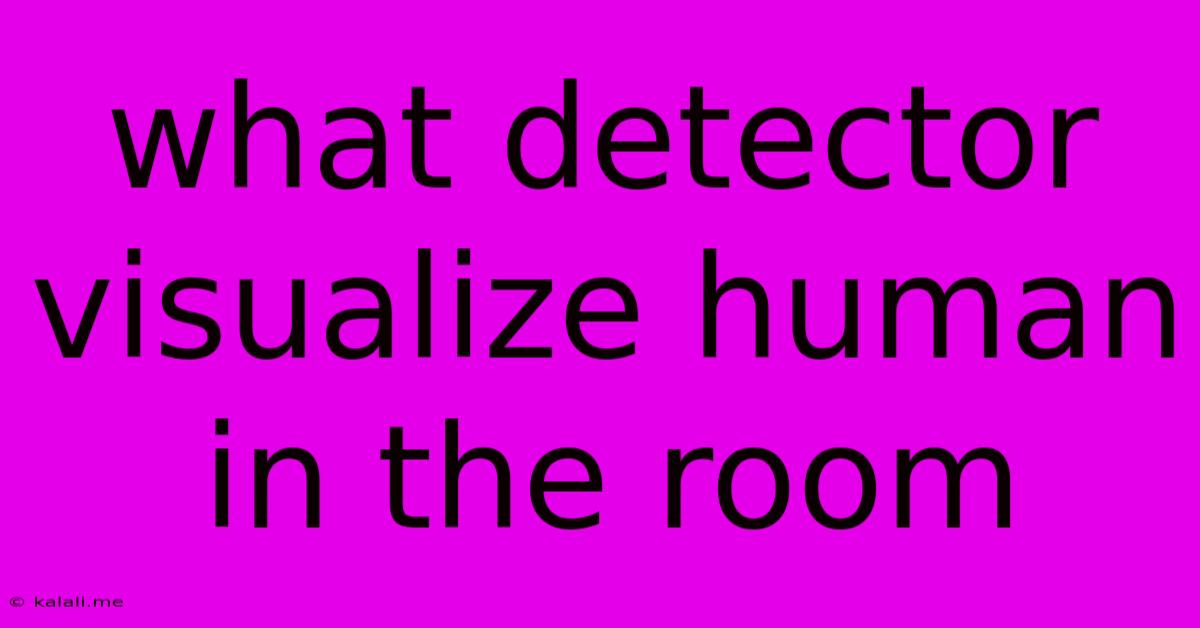What Detector Visualize Human In The Room
Kalali
Jun 06, 2025 · 4 min read

Table of Contents
What Detectors Visualize Humans in a Room? A Comprehensive Guide
Meta Description: Discover the various technologies used to detect and visualize human presence in a room, from simple motion sensors to sophisticated AI-powered systems. Learn their applications and limitations.
Human detection within a confined space like a room has become increasingly important across various sectors. From enhancing security to improving home automation and even assisting healthcare, the ability to accurately visualize human presence is crucial. This article explores the different detectors used to achieve this, outlining their functionalities, advantages, and drawbacks.
Passive Infrared (PIR) Sensors: The Workhorse of Human Detection
PIR sensors are arguably the most common and widely used technology for detecting human presence. They work by detecting the infrared (heat) radiation emitted by a person. Any change in the heat signature within their field of view triggers an alert. While they are inexpensive and relatively low-power, they have some limitations. They can be affected by factors like direct sunlight, strong air currents, and even pets, leading to false positives or negatives. They don't provide visual data; instead, they simply register the presence or absence of heat.
Advantages: Affordable, low power consumption, simple installation.
Disadvantages: Susceptible to environmental factors, limited accuracy, no visual data.
Ultrasonic Sensors: Measuring Distance and Movement
Ultrasonic sensors emit high-frequency sound waves and measure the time it takes for the waves to bounce back. Changes in the echo pattern, caused by movement of an object (like a person), indicate presence. These sensors aren't as sensitive to temperature changes as PIR sensors, but they can be affected by obstacles and reverberations within the room. Like PIR sensors, they don't offer visual identification of the person.
Advantages: Less affected by temperature changes, effective in low-light conditions.
Disadvantages: Affected by obstacles, potential for inaccurate readings due to reflections.
Computer Vision Systems: The Eyes of the Smart Room
Computer vision systems represent a significant advancement in human detection. Utilizing cameras and sophisticated algorithms, including deep learning and machine learning, these systems can not only detect human presence but also visualize individuals within the room. This allows for far more accurate identification and tracking of movement, even differentiating between individuals. However, they require significant computational power and can raise privacy concerns.
Advantages: High accuracy, visual data, potential for advanced analysis (e.g., posture detection, activity recognition).
Disadvantages: High cost, increased computational requirements, privacy implications.
LiDAR (Light Detection and Ranging): Precision and 3D Mapping
LiDAR sensors use laser light to create a 3D map of the environment. By measuring the time of flight of the laser pulses, they can detect and visualize objects with remarkable precision, including people. This technology offers high accuracy and allows for detailed spatial information, but it is significantly more expensive than other options.
Advantages: High accuracy, 3D mapping capability, works well in various lighting conditions.
Disadvantages: High cost, complex setup, potential safety concerns (eye safety).
Radar Sensors: Seeing Through Walls (Limited Visualisation)
Radar sensors, using radio waves, can penetrate obstacles and detect movement behind walls or other obstructions. While not providing visual images of people in the same way as computer vision systems, they can effectively detect human presence even when hidden from direct view. This is particularly useful for security applications.
Advantages: Can detect movement behind obstacles.
Disadvantages: Limited spatial resolution, does not offer direct visual representation.
Choosing the Right Detector: Considerations for Your Needs
The ideal human detection system depends heavily on the specific application and priorities. Factors to consider include:
- Budget: PIR sensors are the most affordable, while computer vision and LiDAR systems are significantly more expensive.
- Accuracy: Computer vision and LiDAR offer the highest accuracy, while PIR and ultrasonic sensors are more prone to errors.
- Privacy concerns: Computer vision systems raise privacy concerns due to their visual data capture.
- Environmental factors: Different sensors are affected by varying environmental conditions.
- Required level of detail: Do you need simple presence detection or detailed visual information and 3D mapping?
Ultimately, understanding the capabilities and limitations of each technology is key to selecting the most suitable human detection solution for your particular needs. The future of human detection in rooms likely involves increasingly sophisticated AI-powered systems capable of real-time analysis and contextual understanding of human behavior within a space.
Latest Posts
Latest Posts
-
Type Must Be Convertible To Identityuser
Jun 07, 2025
-
Car Shakes When Idle And Accelerating
Jun 07, 2025
-
Doctor Who Clara And The Doctor
Jun 07, 2025
-
How To Keep Tomato Plant From Getting Too Tall
Jun 07, 2025
-
Why God Did Not Accept Cains Offering
Jun 07, 2025
Related Post
Thank you for visiting our website which covers about What Detector Visualize Human In The Room . We hope the information provided has been useful to you. Feel free to contact us if you have any questions or need further assistance. See you next time and don't miss to bookmark.